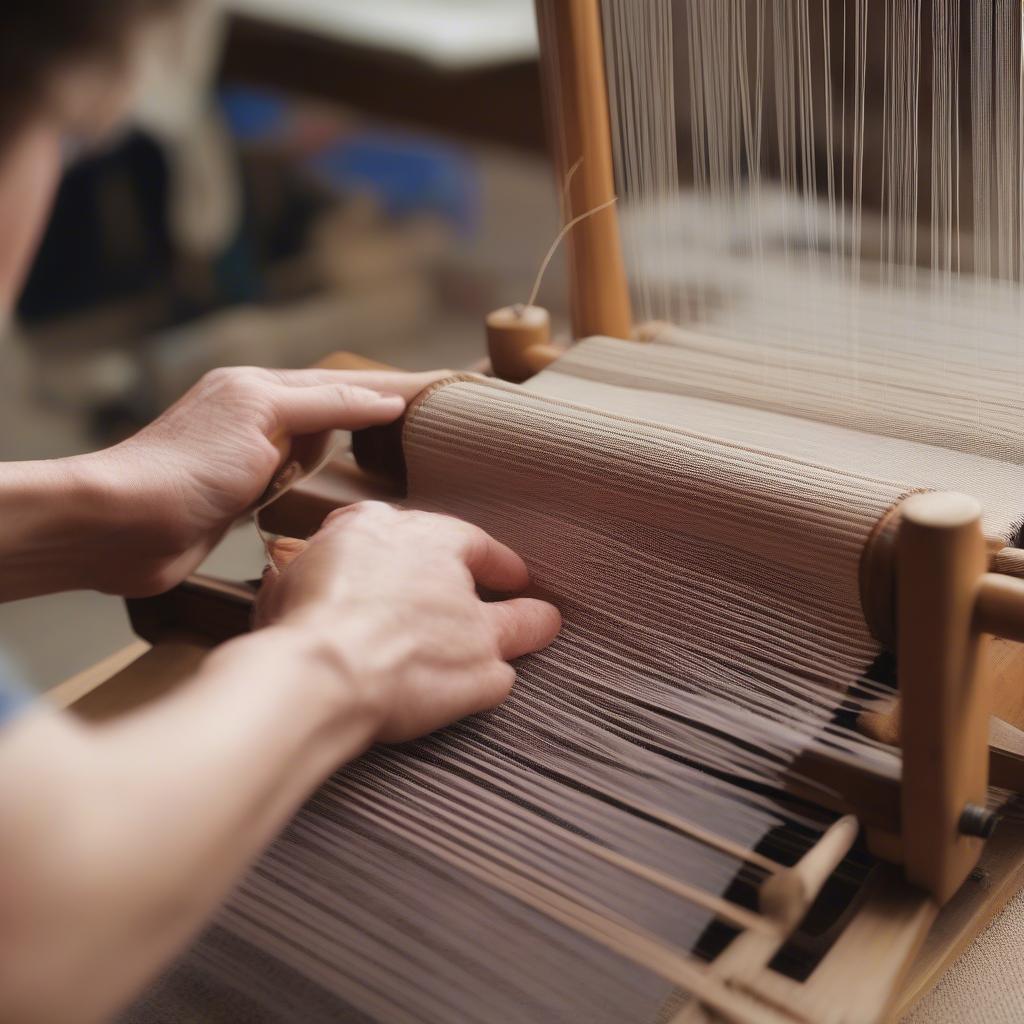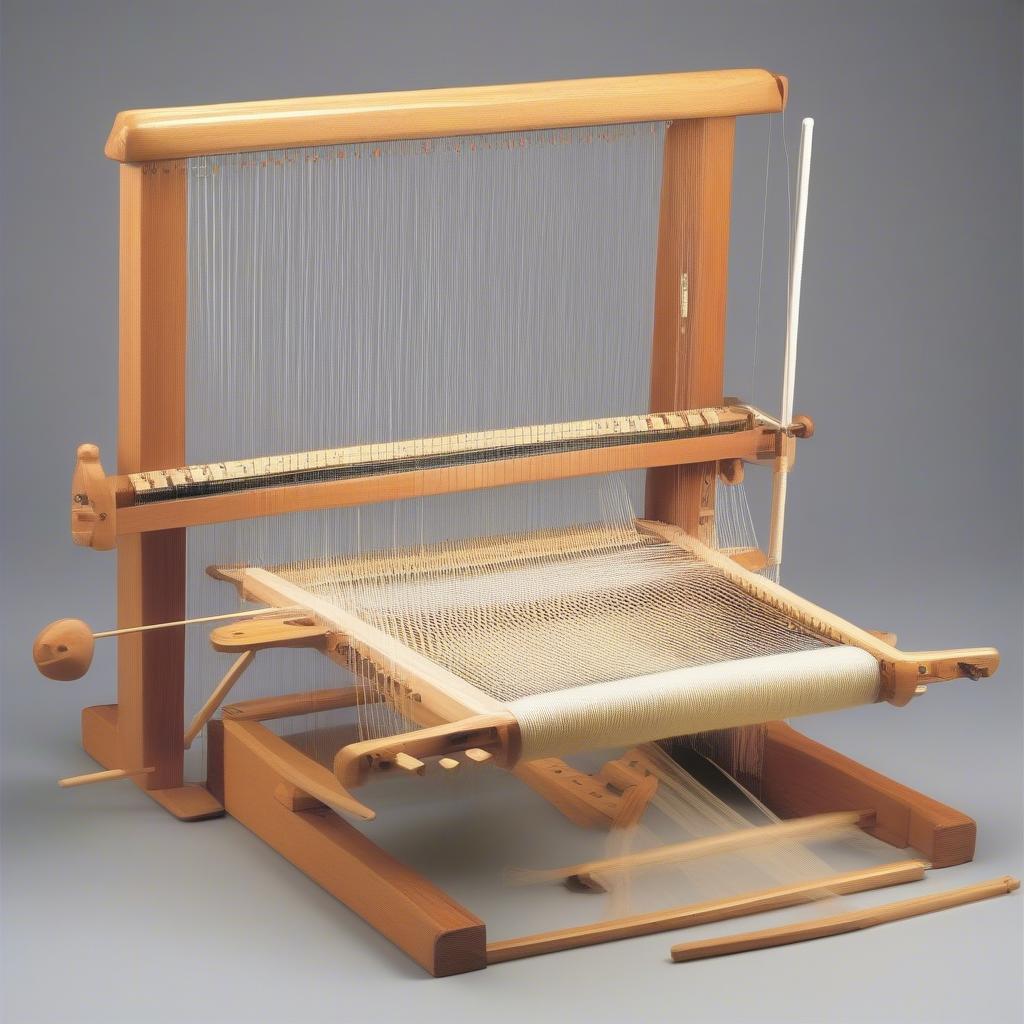Weave Table
Weaving Table Loom: A Comprehensive Guide
A Weaving Table Loom offers a compact and portable way to explore the world of weaving. Whether you’re a beginner or an experienced weaver, understanding the nuances of a weaving table loom can significantly enhance your crafting journey. This guide will delve into everything you need to know about weaving table looms, from choosing the right one to mastering various weaving techniques.  A person weaving on a table top loom, showcasing the process and the finished product.
A person weaving on a table top loom, showcasing the process and the finished product.
Choosing the Right Weaving Table Loom
Selecting the perfect weaving table loom can feel overwhelming with so many options available. Consider your weaving goals, skill level, and budget. A smaller, easy weaving table loom is ideal for beginners, while experienced weavers might prefer a larger loom with more features. Look for sturdy construction and adjustable features like the warp beam and heddles.  Various table top weaving looms, showcasing different sizes and features.
Various table top weaving looms, showcasing different sizes and features.
Understanding Loom Features
Key features to look for include the size of the loom (measured in weaving inches), the number of shafts and heddles, and the type of reed. The reed determines the density of the warp threads. Do some research and compare different models to find the table top weaving looms that best suits your needs.
Setting Up Your Weaving Table Loom
Setting up your weaving table loom correctly is crucial for a successful weaving experience. This involves warping the loom, which means threading the warp yarns onto the loom. Follow the instructions provided with your loom carefully. Accurate warping ensures even tension and a smooth weaving process.
Warping the Loom: A Step-by-Step Guide
- Measure and cut your warp yarn according to your project requirements.
- Create a warp chain or use a warping board to maintain even tension.
- Thread the warp yarn through the reed and heddles, following the desired pattern.
- Secure the warp yarn to the warp beam and cloth beam.
- Tie on and adjust the tension of the warp.
Weaving Techniques on a Table Loom
A weaving table loom allows for various weaving techniques, from plain weave to more complex patterns. Experimenting with different techniques can add depth and texture to your woven creations. diy weaving table loom can also open up new creative possibilities.
Exploring Different Weaving Patterns
- Plain weave: The most basic weave, creating a simple, balanced fabric.
- Twill weave: Creates diagonal lines in the fabric, adding visual interest.
- Tapestry weave: Allows for intricate designs and color variations.
“A well-maintained weaving table loom is a weaver’s best friend. Regular cleaning and lubrication will ensure smooth operation and prolong its lifespan,” says Emily Carter, a master weaver with over 20 years of experience.  Close-up of woven fabric on a table loom, showcasing different weaving patterns.
Close-up of woven fabric on a table loom, showcasing different weaving patterns.
Maintaining Your Weaving Table Loom
Proper maintenance ensures the longevity and optimal performance of your weaving table loom. Regularly check for loose screws or damaged parts. Keep the loom clean and free of dust and debris.
Troubleshooting Common Loom Issues
- Broken warp threads: Carefully tie the broken ends together.
- Uneven tension: Adjust the tension of the warp threads.
- Sticky heddles: Lubricate the heddles with a dry lubricant.
Reading a Weaving Draft
Understanding how to read a weaving draft for a table loom is essential for creating complex patterns. A weaving draft is a visual representation of the weaving structure, indicating which heddles to lift for each weft thread. Take the time to learn how to interpret these drafts.
“Learning to read a weaving draft opens up a world of possibilities. It allows you to create intricate patterns and truly express your creativity,” advises John Miller, a renowned textile designer.
Conclusion
A weaving table loom is a versatile tool that allows you to explore the art of weaving. From choosing the right loom to mastering various weaving techniques, understanding the nuances of this craft enhances your creative journey. With practice and patience, you can create beautiful and unique woven pieces on your weaving table loom.
FAQ
-
What is the best weaving table loom for beginners? A rigid heddle loom or a small four-shaft table loom are good choices for beginners.
-
What materials can I weave on a table loom? You can weave with a variety of yarns, including cotton, wool, linen, and silk.
-
How do I warp a weaving table loom? Follow the instructions provided with your specific loom model. There are also many online tutorials available.
-
What is a weaving draft? A weaving draft is a visual representation of the weaving pattern.
-
Where can I find weaving patterns for table looms? Books, magazines, and online resources offer a wide variety of weaving patterns.
-
What is the harrisville table top loom for weaving? Harrisville Designs produces high-quality table looms that are popular among weavers.
-
How do I maintain my weaving table loom? Regular cleaning and lubrication will keep your loom in good working condition.
For any assistance or further inquiries, feel free to reach our 24/7 customer service team at +84 388 951 999. Our offices are located in Hanoi, Vietnam and Tech Avenue, Suite 12, San Francisco, CA 94105, USA.
